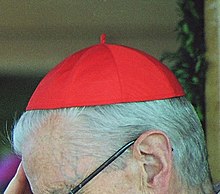| Revision as of 17:09, 27 November 2011 editMikeWazowski (talk | contribs)Extended confirmed users33,732 edits Undid revision 462703884 by Djathinkimacowboy (talk) unreferenced WP:OR← Previous edit | Revision as of 17:17, 27 November 2011 edit undoDjathinkimacowboy (talk | contribs)4,216 edits Undid revision 462757821 by MikeWazowski (talk) This is not OR as the editor well knows. None of the article is OR.Next edit → | ||
| Line 6: | Line 6: | ||
| The zucchetto is a descendant of the ]. |
The zucchetto is a descendant of the ]. Until very recently, the typical construction of the zucchetto has been an outer shell of watered silk and an inner lining of chamois leather. The leather helped keep the head warm, keep the zucchetto on the head, and added a desired stiffness to the entire zucchetto. Today it is most commonly made entirely of silk or polyester fabric. The zucchetto has always been constructed the same way: sewn together in eight triangular panels. Jutting from the centre of the zucchetto at the top is the "stem", known as ''stirpis'' or ''stirpes''. The stem is made of a twisted loop of silk cord and is meant to make the handling of the zucchetto easier. The stirpes is the main distinction between the zucchetto and the Jewish kippah. | ||
Revision as of 17:17, 27 November 2011


The zucchetto (plural zucchetti, Italian for "small gourd"), a/k/a pileolus in Latin and calotte/calotta in France, Italy and Hispanic nations, is a small skullcap worn by clerics of the Roman Catholic Church, as well as in Anglicanism.
It was originally adopted probably around the beginning of the Byzantine Era for practical reasons, to keep clerics' tonsured heads warm. It has survived as a traditional item of dress. Its name may derive from its resemblance to half of a pumpkin, or from the fact that it covers a "whole pumpkin" (i.e., the head). Its appearance is almost identical to the Jewish Kippah (yarmulke), though its significance is quite different.
The zucchetto is a descendant of the beret. Until very recently, the typical construction of the zucchetto has been an outer shell of watered silk and an inner lining of chamois leather. The leather helped keep the head warm, keep the zucchetto on the head, and added a desired stiffness to the entire zucchetto. Today it is most commonly made entirely of silk or polyester fabric. The zucchetto has always been constructed the same way: sewn together in eight triangular panels. Jutting from the centre of the zucchetto at the top is the "stem", known as stirpis or stirpes. The stem is made of a twisted loop of silk cord and is meant to make the handling of the zucchetto easier. The stirpes is the main distinction between the zucchetto and the Jewish kippah.
In the Orthodox tradition, a seven-panel zucchetto called a phiro is worn by priests. It is always black and embroidedered with black Orthodox crosses.
All ordained members of the Roman Catholic Church are entitled to wear the zucchetto. As with much ecclesiastical apparel, the colour of the zucchetto denotes the wearer's rank: the pope's zucchetto is white, those worn by cardinals are red or scarlet, and those of bishops, territorial abbots and territorial prelates are Violet (color). Priests and deacons wear a black zucchetto although the use of the zucchetto by priests in actual practice is extremely rare aside from abbots. However, it is quite common for priests assigned to the Vatican.
A black zucchetto with red piping was formerly the mark of a protonotary apostolic or canon, but this is no longer authorized. A white zucchetto is worn by Premonstratensian prelates. A brown zucchetto, and similar black skullcap, is sometimes worn by Franciscan friars and Benedictine or Trappist monks respectively, but this is usually a slightly more substantial cap used for actual head-warming rather than as a ceremonial accoutrement.
All clerics who hold the episcopal character (that is to say, all bishops, whether the pope, cardinals, titular bishops or diocesan bishops) wear the zucchetto throughout most of the Mass, removing it at the commencement of the Preface and replacing it at the conclusion of the Communion. A short stand placed on the altar, usually made of brass or wood and known as a funghellino is used in some churches to hold the zuchetto during that part of the service. Also, the zucchetto is worn beneath the mitre (the zuchetto is worn beneath the mitre). This gives the alternate name for the zucchetto, submitrale.
The late Pope John Paul II often gave guests the zucchetto he was wearing as a keepsake if presented with a new one as a gift. Pope Benedict XVI has continued with the practice, which was started in the modern era by Pope Pius XII.
If visiting the pope, one may wish to speak with his secretary beforehand about the practice, and confirm that the new zucchetto is the correct size and is otherwise appropriate. In practice, the pope does not actually give the visitor his own zucchetto, but rather puts on the gift zucchetto for a moment and returns it thereafter. Bishops such as Fulton J. Sheen as well as Pope Pius XII actually gave their old zucchetto in exchange for the newly offered one.
The zucchetto is worn by some Anglican bishops, and is used approximately like that of the Roman Catholic Church. The exception is the Anglican Church rejects the Catholic "Church violet" and instead uses purple.
References
- Kilgour, Ruth Edwards (1958). A Pageant of Hats Ancient and Modern. R. M. McBride Company.
- McCloud, Henry (1948). Clerical Dress and Insignia of the Roman Catholic Church. The Bruce Publishing Company, Milwaukee.
- Philippi, Dieter (2009). Sammlung Philippi - Kopfbedeckungen in Glaube, Religion und Spiritualität,. St. Benno Verlag, Leipzig. ISBN 978-3-7462-2800-6.